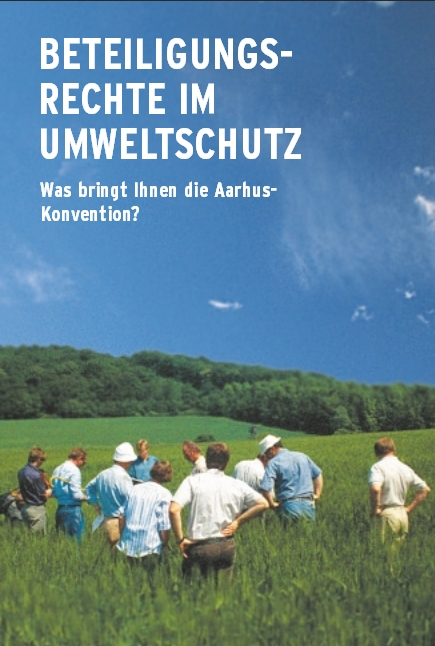Beteiligungsrechte im Umweltschutz
Was bringt Ihnen die Aarhus-Konvention?
- Publication
- Citation
Beyer, Peter; Anneke Klasing and Isabelle-K. Charlier 2004: Beteiligungsrechte im Umweltschutz. Was bringt Ihnen die Aarhus-Konvention? Berlin: Bundesministerium für Umwelt, Naturschutz und Reaktorsicherheit.
This brochure introduces the Aarhus Convention and shows which rights to information, to participation and to file suit citizens are entitled to in the area of the environment, and how they can exercise these rights.
The brochure addresses the three pillars of the Aarhus Convention:
- The right to access to environmental information
- Public participation in decision-making
- The access to justice
The brochure can be downloaded [pdf, 1.5 MB, German].
Background
Effective environmental protection is only possible today through the active participation of the public. Citizens should be enabled to take their own responsibility for the environment more seriously. As a response, 37 countries adopted the Aarhus Convention in June 1998. The Convention stipulates important rights for the participation of citizens in environmental protection.
The Right to Access to Environmental Information
The right to access to environmental information facilitates the participation of citizens in the decision-making process. Information on the environment helps people to develop viewpoints that they can then bring to the decision-making process.
Public participation in decision-making
The Convention sees public participation in important, environmentally relevant projects as a second main goal. The involvement of citizens in the licensing procedure for the building of industrial sites, for example, can ensure that environmental factors are taken into account.
Access to Justice
To ensure enforcement of the rights to access to environmental information and to participation in decision-making procedures, the Aarhus Convention guarantees access to justice. Institutional decisions can be reviewed by courts in cases where violations of environmental regulations are possible.
Pollutant Release and Transfer Register – PRTR
To simplify the issue of citizens' access to environmentally relevant information, a protocol to the Aarhus Convention called the "Protocol on Pollutant Release and Transfer Registers" was adopted in 2003. Pollutant Release and Transfer Registers should provide information on emissions from industrial facilities, garbage disposal transport and diffuse pollutant sources (like traffic or agriculture, for example). These facts will be made accessible to the public through an electronic database (the Register). The Register is structured so that a citizen can identify a facility by its geographic location, by the type of activity, or by the name of the owner, operator or the pollutant itself. A citizen can then see what kind of pollutants in what amount the facility emits and how much waste is shipped outside the facility.
The European Pollutant Emission Register – EPER
The European Commission has already introduced a similar instrument. The EPER contains emissions data for many intensively-polluting industrial facilities in Europe. It registers the release of 50 toxic substances into the air and water. Citizens can inquire about individual locations in Europe using the EPER database. The EPER will be expanded in the future to comply with all the requirements of the PRTR Protocol as well.




